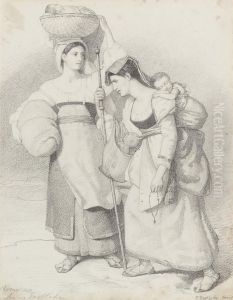Sir Charles Herbert Eastlake Paintings
Sir Charles Herbert Eastlake was a British painter, gallery director, and writer who played a significant role in the Victorian art world. Born on March 17, 1793, in Plymouth, Devon, Eastlake initially studied at the Royal Academy schools in London. He was deeply influenced by the works of the old masters during his travels across Europe, especially Italy, where he spent considerable time. His early works were primarily historical and biblical subjects, but he gradually shifted towards landscape painting and scenes inspired by his travels. Eastlake's style was characterized by its meticulous attention to detail and a strong emphasis on classical beauty, reflecting the influence of Italian Renaissance art.
Eastlake's contributions to the art world were not limited to his paintings. In 1850, he was appointed the first President of the Photographic Society, showcasing his interest in the emerging field of photography and its relationship to traditional art forms. However, his most significant role came in 1855 when he was appointed as the director of the National Gallery in London, a position he held until his death. During his tenure, Eastlake was instrumental in expanding the gallery's collection, acquiring many important works of art. He was known for his rigorous approach to authentication and his efforts to ensure that the National Gallery's acquisitions were of the highest quality. Eastlake also played a pivotal role in the development of art conservation practices, emphasizing the importance of preserving artworks for future generations.
As a writer, Eastlake contributed significantly to the literature on art, with his most notable work being 'Materials for a History of Oil Painting', which was published posthumously in 1869. This work remains a valuable resource for understanding the techniques and materials of old master painters. Eastlake's dedication to the arts was recognized by his knighthood in 1850, and he was elected as a member of the Royal Academy in 1827.
Sir Charles Herbert Eastlake died on December 24, 1865, leaving behind a legacy that spanned across painting, art collection, and art scholarship. His impact on the British art scene and particularly on the National Gallery's collection was profound, and his works and writings continue to influence art historians and conservators to this day.
